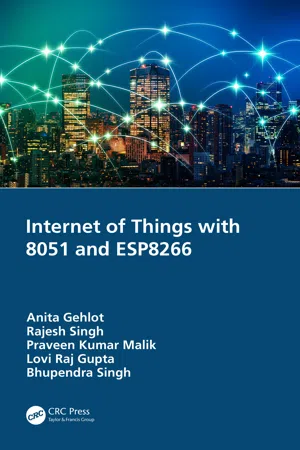
Internet of Things with 8051 and ESP8266
- 178 pages
- English
- ePUB (mobile friendly)
- Available on iOS & Android
Internet of Things with 8051 and ESP8266
About This Book
Internet of Things with 8051 and ESP8266 provides a platform to get started with the Internet of Things (IoT) with 8051. This book describes programming basics and how devices interface within designed systems. It presents a unique combination of 8051 with ESP8266 and I/O devices for IoT applications supported by case studies to provide the solutions to real-time problems. The programs and circuits have been tested on real hardware and explore different areas in IoT applications. Divided into four sections, it explains the customized boards for IoT applications followed by the means by which 8051 and ESP8266 interface with I/O devices. It spans levels from basic to advanced interfacing with special devices, server design, and data logging with different platforms.
Features:
-
- Covers how I/O devices interface with 8051 and ESP8266
-
- Explains the basic concepts of interfacing complexity using applications with examples
-
- Provides hands-on practice exercises with 8051 and ESP8266 for IoT applications
-
- Discusses both case studies and programming tests on real hardware during industrial and student projects
-
- Reviews the integration of smart devices with IoT
Internet of Things with 8051 and ESP8266 is intended for senior undergraduate and graduate students in electrical and electronics engineering, but anyone with an interest in the professional curriculum of electrical and electronics engineering will find this book a welcome addition to their collection.
Frequently asked questions
Information
Section B
Interfacing of 8051 Microcontroller and NuttyFi/ESP8266 with I/O devices
5 Interfacing of 8051 and NuttyFi/ESP8266 with LED
Color | Semiconductor Material | Wavelength [nm] | Voltage Drop [ΔV] |
|---|---|---|---|
| Infrared | Gallium arsenide (GaAs) Aluminum gallium arsenide (AlGaAs) | λ > 760 | ΔV < 1.63 |
| Red | Aluminum gallium arsenide (AlGaAs) Gallium arsenide phosphide (GaAsP) phosphide (AlGaInP) | 610 < λ < 760 | 1.63 < ΔV < 2.03 |
| Orange | Gallium arsenide phosphide (GaAsP) Aluminum gallium indium phosphide (AlGaInP) | 590 < λ < 610 | 2.03 < ΔV < 2.10 |
| Yellow | Gallium arsenide phosphide (GaAsP) Aluminum gallium indium phosphide (AlGaInP) | 570 < λ < 590 | 2.10 < ΔV < 2.18 |
| Green | Aluminum gallium indium phosphide (AlGaInP) Aluminum gallium phosphide (AlGaP) Indium gallium nitride (InGaN) | 500 < λ < 570 | 1.9[93] < ΔV < 4.0 |
| Blue | Zinc selenide (ZnSe) Indium gallium nitride (InGaN) Synthetic sapphire, Silicon carbide (SiC) | 450 < λ < 500 | 2.48 < ΔV < 3.7 |
| Violet | Indium gallium nitride (InGaN) | 400 < λ < 450 | 2.76 < ΔV < 4.0 |
| Ultraviolet | Indium gallium nitride (InGaN) (385–400 nm) Diamond (235 nm) Boron nitride (215 nm) Aluminum gallium nitride (AlGaN) | Λ < 400 | 3 < ΔV < 4.1 |
| Purple | Dual blue/red LEDs, blue with red phosphor, or white with purple plastic | Multiple types | 2.48 < ΔV < 3.7 |
| White | Cool/Pure White: Blue/UV diode with yellow phosphor Warm White: Blue diode with orange phosphor | Broad spectrum | 2.8 < ΔV < 4.2 |
Table of contents
- Cover
- Half Title
- Title Page
- Copyright Page
- Contents
- Preface
- Author’s Biographies
- SECTION A Basics of 8051 Microcontroller and IoT
- SECTION B Interfacing of 8051 Microcontroller and NuttyFi/ESP8266 with I/O devices
- SECTION C Interfacing of 8051 Microcontroller and NuttyFi/ESP8266 with Special Devices
- SECTION D Case Study Based on Data Logger to Cloud Server
- Index